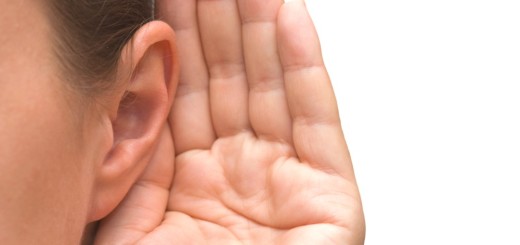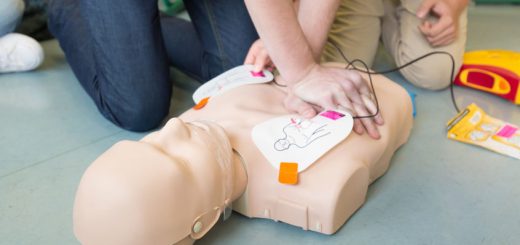First Aid for Jellyfish Stings: 4 Expert Tips
Enjoying and swimming in the water is extremely fun, but getting stung by a jellyfish is not so fun, right?
Well, jellyfish stings are a common occurrence on the beach. However, it is crucial to take immediate steps to relieve the pain and prevent the situation from worsening.
This article will discuss jellyfish sting, its symptoms, the necessary steps to take, and ways to soothe the pain.
We will also share when to seek medical attention and 4 prevention tips. Stay with us to learn more about first aid for jellyfish stings.
Jellyfish Stings and its Common Symptoms
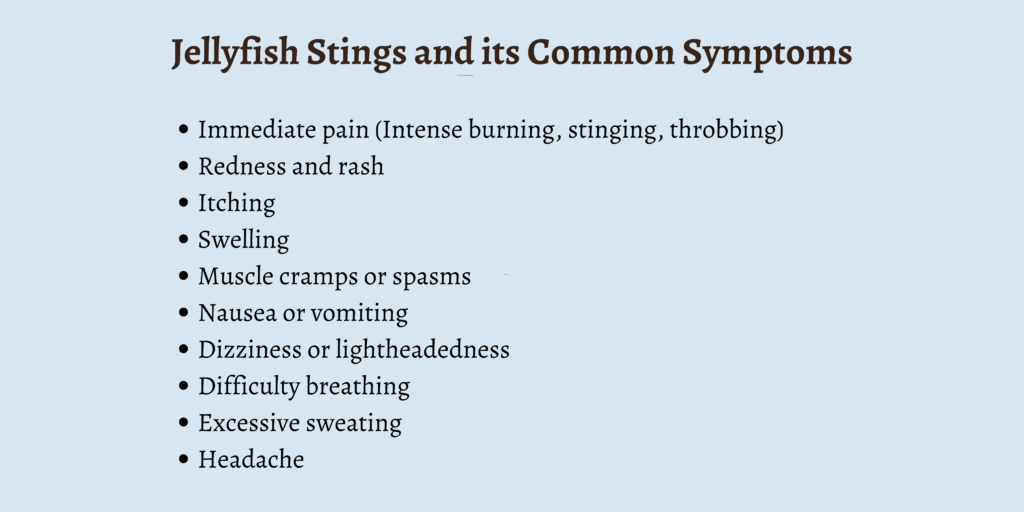
Jellyfish are fascinating creatures, but behind their beauty is hidden a surprising weapon: nematocysts, stinging cells. These cells contain microscopic barbed needles that trigger the release of venom when they come into contact with skin.
When a jellyfish tentacle touches your skin, it injects a venom that can cause various reactions. The severity of the sting depends on the jellyfish type. The stings are painful, but they’re rarely life-threatening.
It is important to recognize the signs and symptoms of jellyfish stings. Below listed are a few common symptoms.
- Immediate pain (Intense burning, stinging, throbbing)
- Redness and rash
- Itching
- Swelling
- Muscle cramps or spasms
- Nausea or vomiting
- Dizziness or lightheadedness
- Difficulty breathing
- Excessive sweating
- Headache
Symptoms appear within minutes of being stung, and in rare cases, a severe allergic reaction can also occur.
Immediate Steps After Getting Stung
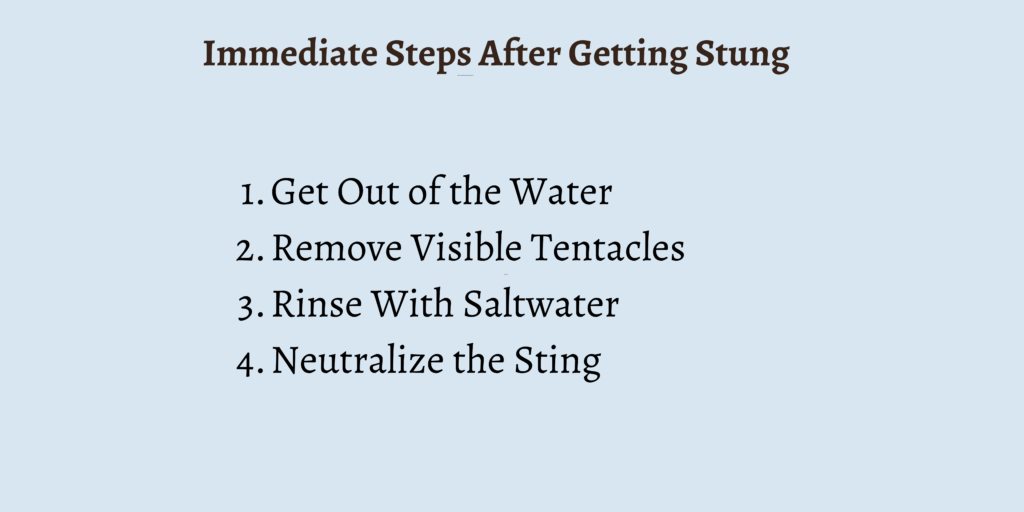
Getting stung is a frightening experience, but taking the right steps minimizes discomfort and prevents the sting from worsening. If you get stung by a jellyfish, these are the immediate steps you can take:
Get Out of the Water
The very first step is to remove yourself from the water as quickly as possible. Jellyfish tentacles can release venom even when detached, so avoid brushing against them and get out of the water safely.
Remove Visible Tentacles
If you see any visible jellyfish tentacles on your skin, carefully remove them. Do not try to remove them with bare hands; avoid direct contact. Wear gloves (latex or rubber) if available.
You can also use tweezers to remove tentacles; however, hold them at the base to avoid squeezing and releasing more venom. If you do not have gloves or tweezers, gently brush sand over the affected area.
Do not rub the stung area with a towel or bare hands; it can worsen the situation.
Rinse With Saltwater
Avoid rinsing the affected area with fresh water, as it can aggravate the sting and can trigger remaining nematocysts. Instead, rinse with salt water for 20-30 seconds.
Neutralize the Sting
Take necessary steps to neutralize the sting; however, the action depends on the type of jellyfish. For example, applying vinegar is helpful for most jellyfish stings, but for some, vinegar can worsen the situation.
Soothing the Sting
After taking the initial steps to remove tentacles, it’s time to focus on soothing the discomfort. Let’s know some relief methods:
- Hot Water Soak: immerse the affected area in hot water for 30-45 minutes. The water temperature should be tolerable to avoid burns. Hot water helps to remove any remaining nematocysts and provides relief.
- Over-the-counter Medications: You can take over-the-counter medications such as acetaminophen (Tylenol) or ibuprofen (Advil) to relieve pain and inflammation. Consider consulting a doctor before consuming any medicine, especially for children and allergic people.
- Calamine Lotion: Applying calamine lotion directly to the stung area helps to relieve itching and irritation.
- Hydrocortisone Cream: This cream is also helpful in reducing inflammation and itching.
Avoid scratching the affected area, apply a cool compress, and wear loose clothing.
When to Seek Medical Attention
Some jellyfish stings require immediate medical attention. Understand when to head to the doctor or emergency room:
Seek immediate medical attention if you experience:
- Difficulty Breathing: If you face difficulty breathing, it is a serious issue and indicates a severe allergic reaction called anaphylaxis. Immediately go to the nearest emergency room.
- Chest Pain: Chest pain is also a serious symptom and needs immediate medical attention.
- Severe Swelling: If the affected area is swelled and it is getting extreme, especially around the face, eyes, or genitals, you must instantly visit the hospital.
- Nausea and Vomiting: If you experience persistent nausea and vomiting, seek medical help before it worsens.
- Muscle Cramps and Weakness: Severe muscle cramps and weakness are also not good signs; therefore, it’s better to consult your doctor.
- Loss of consciousness: Experiencing dizziness and fainting? Seek immediate medical help.
You should also see your doctor if:
- The pain is extremely severe, and over-the-counter medicines do not provide relief
- The affected area has excessive swelling, redness, or blisters
- You have a chronic health condition or compromised immune system
- Unsure about the type of jellyfish that stung you
- The sting affects your eyes
4 Expert Tips for Prevention
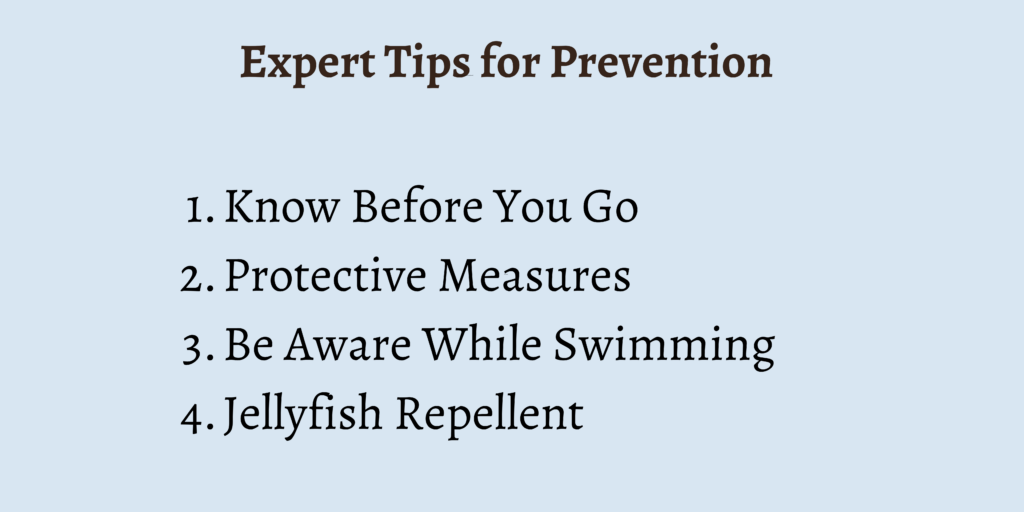
You can take several preventative measures to reduce your risk of encountering jellyfish or getting stung by them. Look at some of the tips given below.
1. Know Before You Go
When you’re headed to a beach, research the type of jellyfish commonly found in that location and during that time of the year beforehand. This helps understand potential risks.
You can ask lifeguards (if present) about recent jellyfish sightings and any particular advice they wanna share with swimmers. Look for posted warnings about jellyfish presence.
2. Protective Measures
Wear a wetsuit or rashguard while swimming in jellyfish-prone areas. Specialized stinger suits might also be available for purchase.
3. Be Aware While Swimming
Avoid swimming in isolated areas, and swim in areas where other swimmers are present. When you enter the water, shuffle your feet to scare away any resting creatures, and also, keep an eye out for jellyfish in the water. They may be present near the surface or in areas with seaweed.
4. Jellyfish Repellent
Some commercially available jellyfish repellent lotions repel jellyfish; however, the effectiveness of these lotions is unclear, but many people use them. A commercial jellyfish sting kit is also available.
FAQs
What’s the first step to soothe jellyfish stings?
After removing the tentacles and rinsing the affected area with saltwater, immerse it in hot water for several minutes.
Is chest pain a symptom of a jellyfish sting?
Yes, chest pain is a symptom of a jellyfish sting. If you experience severe pain in the chest, seek immediate medical help.
Are over-the-counter medicines helpful for jellyfish stings?
Yes, over-the-counter medication can be taken to relieve pain, irritation, and inflammation.
Is cold water or ice packs good for jellyfish stings?
Yes, you can rinse with cold water or put ice packs on the affected area. However, hot water is more effective for the sting.
Conclusion
It is common to get stung by a jellyfish while you are inside the water. Most jellyfish venom is not dangerous except for a few. Following the above-mentioned steps and tips will help you treat the condition. However, in severe cases, it is necessary to seek medical help.
Understand your condition for proper treatment.

